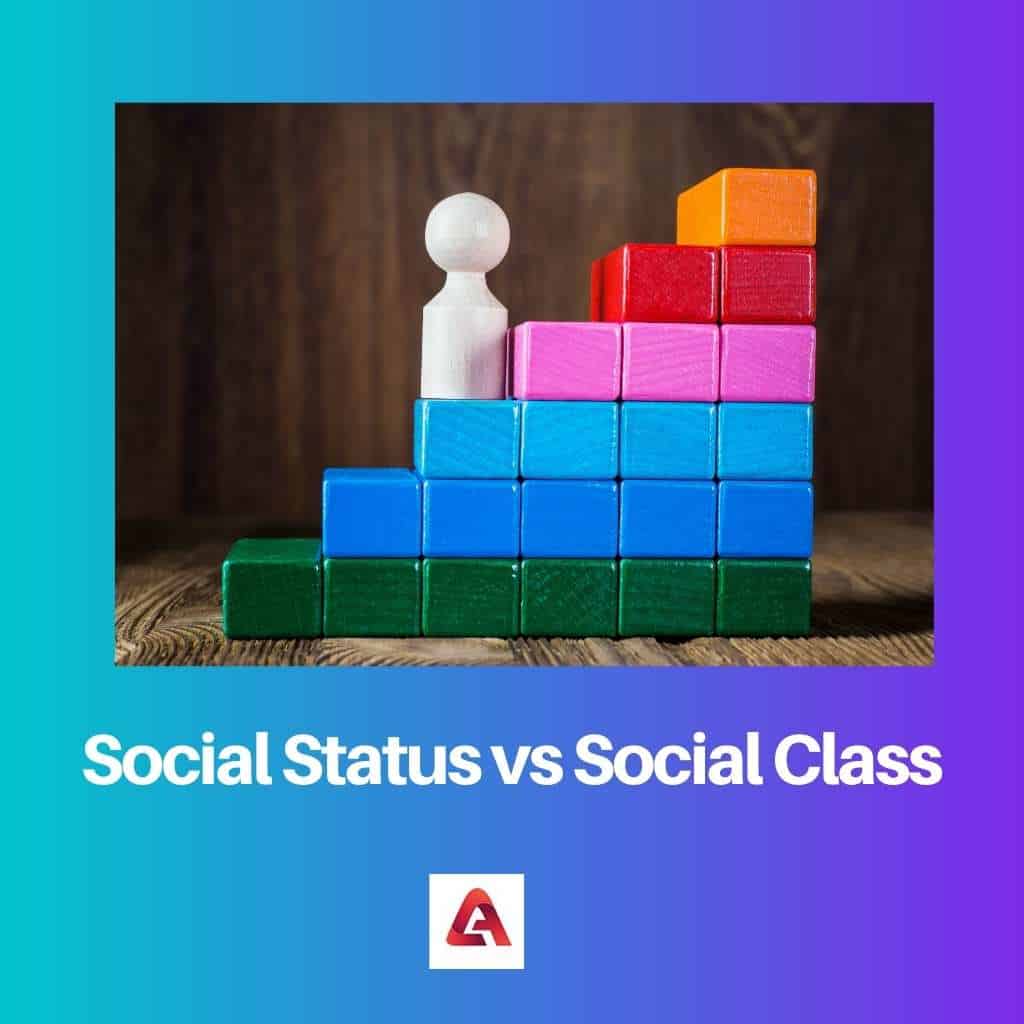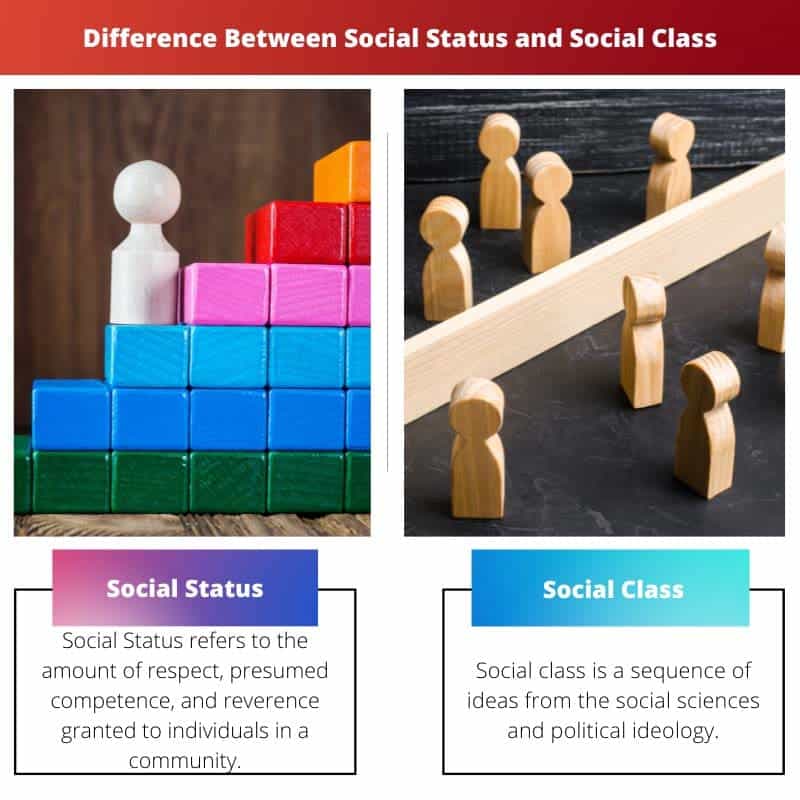In sociology, social status and social class are two key ideas. Many aspects of society are determined by an individual’s social class and social standing. These two names are frequently used interchangeably. These, however, are not the same.
Key Takeaways
- Social status refers to an individual’s position or rank in society, which can be determined by occupation, education, and income.
- Social class refers to individuals who share similar economic, social, and cultural characteristics and have similar power and influence in society.
- Social class is a broader concept than social status and can include various subgroups, such as the working class, middle class, and upper class.
Social Status vs Social Class
The difference between social status and social class is that social status is determined by characteristics such as familial descent, honor and significance of a profession, and social standing. On the other hand, social class is determined by financial reasons.

Social Status refers to the amount of respect, presumed competence, and reverence granted to individuals in a community. It is defined by the existence of culturally regarded signs of superiority or inferiority.
It is the degree of social value a person is thought to have been referred to as their social standing.
Social class is a sequence of ideas from the social sciences and political ideology that are based on patterns of social stratification that emerge in a class society, in which people are classified into a hierarchy of social classifications.
Concepts of social class were not fully developed until the 19th century, when the modern social sciences, notably sociology, evolved.
Comparison Table
| Parameters of Comparison | Social Status | Social Class |
|---|---|---|
| Introduced by | Max Weber | Karl Marx |
| Can be traced in | 2000BC | Early 19th century |
| Definition | The position of a person in society in respect to others. | A society’s segmentation based on social and economic standing |
| Basis | Family descent, occupation, culture | Economic background |
| Types | Ascribed social status and achieved social status | Upper, upper-middle, lower-middle, working-class, and poor |
What is Social Status?
A person’s social status refers to where they stand in society concerning others. It may also relate to a person’s level of honor, respect, and deference. Some individuals have a higher social standing than others.
A person’s social standing can be assigned or earned. The social standing that is allocated at birth, regardless of one’s talents, is known as ascribed social status.
Furthermore, an attributed connection is frequently based on sex, age, familial affiliations, religion, and ethnicity. A person born into a poor household, for example, is considered to have a lower social position.
Some people, on the other hand, attain social rank as a result of their talents, abilities, and efforts.
This might be determined by things such as education, employment, achievements, and marital status. For example, if someone is born into a lower social class but receives a good education and a prominent career, he will rise to a higher social position.
People frequently utilize the hierarchy of social rank to allocate resources, leadership positions, and other types of power in a society. It is, nevertheless, always feasible to modify one’s social rank and have it accepted by society.
The word “status” refers to a position in a social system that is inhabited by specified actors (i.e., persons or social organizations) and is defined by a set of roles that determine the incumbents’ expected patterns of interrelationships with incumbents of related statuses.
The associated ideas of prestige, unequal distribution of relatively limited social resources and an unequal chance for earning them, and power, i.e., the capacity to influence others to achieve one’s aims, can be used to rank statuses hierarchically.
The phrase “social status” is widely used when considering statuses from a hierarchical perspective.
The degree of social value a person is thought to have is referred to as their social standing. Status is determined by held ideas about who people of a community feel has a higher or lower social value, who they believe has superior competence or moral qualities.
What is Social Class?
The separation of society into social classes or classes is based on social and economic position. The socioeconomic standing of people describes the same. A country’s or society’s population is divided into several classes.
In addition, several sociologists advise that this division be divided into five social classes: top, upper-middle, lower-middle, working-class, and destitute.
Elites, leaders and the wealthiest families in society, make up the upper class.
Administrative officials, physicians, attorneys, engineers, teachers, and other professionals make up the upper and lower-middle classes, while those engaged in menial labor make up the working class.
A social class, known as a class, is a group of people who share the same socioeconomic standing within a community.
The notion of class, defined as a group of people who share comparable economic conditions, has been frequently employed in censuses and social mobility studies, in addition to being essential in social theory.
In the early nineteenth century, the term class began to replace phrases like rank and order as descriptors of society’s primary hierarchical categories.
After the late-eighteenth-century economic and political upheavals, this use mirrored changes in the organization of western European society.
Despite disagreements over the notion of class, social scientists agree on the features of the major socioeconomic classes in modern nations.
Main Differences Between Social Status and Social Class
- The term social status was coined by Max Weber while social class was introduced by Karl Marx.
- Social status may be traced back to the beginning of the Bronze Age, 4,000 years ago, long before Julius Caesar sat over the Forum, and social class was first established in the early nineteenth century.
- Social status refers to a person’s position in society in comparison to others, whereas social class refers to a society’s stratification based on social and economic status.
- Social status is determined by characteristics such as familial descent, occupational prominence, and cultural standing, whereas social class is determined by a person’s economic background.
- Ascribed social status and achieved social status are the two types of social status. However, the social class may be divided into five categories: upper, upper-middle, lower-middle, working-class, and impoverished.

- https://psycnet.apa.org/record/1949-04741-000
- https://psycnet.apa.org/record/2019-00292-027
- https://books.google.com/books?hl=en&lr=&id=IX1XFrI6qgAC&oi=fnd&pg=IA1&dq=social+status+and+social+class+&ots=9HkKP6jXls&sig=C6Jwcu3kOTZjpwhWxxpSyzScMdE
